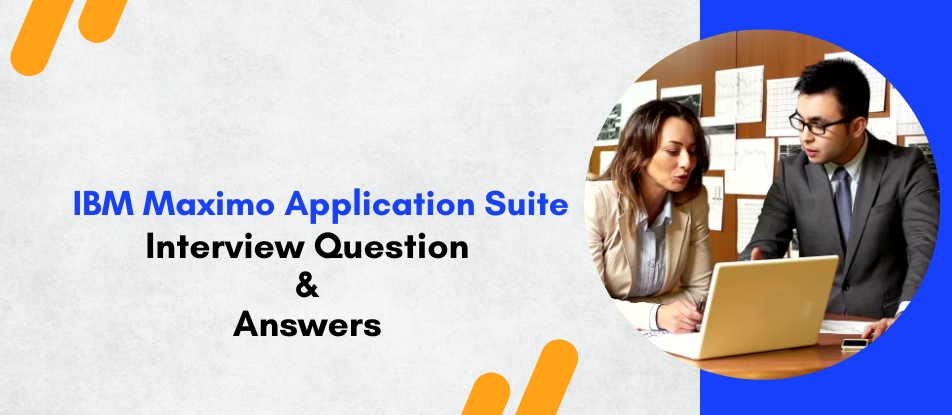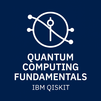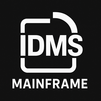
IBM Maximo Application Suite (MAS) training equips learners with comprehensive skills in managing enterprise assets using cutting-edge technologies like AI, IoT, and advanced analytics. The course covers key modules such as Maximo Manage, Predict, Monitor, Health, Assist, and Mobile. Participants will master deploying MAS on Red Hat OpenShift, integrating with IT/OT systems, and implementing predictive maintenance strategies. This training enables organizations to enhance asset performance, optimize maintenance, and drive Industry 4.0 initiatives.
IBM Maximo Application Suite Training Interview Questions Answers - For Intermediate
1. How does MAS handle asset lifecycle management?
MAS supports complete asset lifecycle management—from planning and acquisition to operations, maintenance, and disposal. It enables tracking of asset performance, health, costs, and work history. Users can optimize asset utilization, extend useful life, and make data-driven decisions for asset replacement or upgrades, enhancing overall return on investment (ROI).
2. What is the role of Maximo Assist?
Maximo Assist is an AI-powered virtual assistant designed to help field technicians and maintenance workers. It provides contextual guidance, troubleshooting steps, and best practices while technicians perform tasks. This improves worker productivity, reduces errors, and helps train new personnel by delivering on-demand knowledge.
3. Explain the concept of AppPoints in MAS licensing.
AppPoints is the flexible licensing system used in MAS. Customers purchase a pool of AppPoints and allocate them to different applications within the suite. This consumption-based model allows organizations to scale usage up or down across various components (Manage, Monitor, Predict, etc.) as their business needs evolve.
4. What are some key use cases of MAS in asset-intensive industries?
MAS is used for various scenarios: predictive maintenance in manufacturing, asset health monitoring in utilities, equipment lifecycle tracking in transportation, regulatory compliance in oil & gas, and smart facilities management in healthcare. It helps reduce downtime, ensure compliance, improve safety, and optimize operational costs.
5. What types of data integrations are supported by MAS?
MAS supports multiple integration methods, including REST APIs, Web Services, and IBM Maximo Integration Framework (MIF). It can connect with ERP systems, IoT platforms, condition monitoring systems, Geographic Information Systems (GIS), financial applications, and other enterprise solutions to enable seamless data flow and holistic insights.
6. How does MAS support condition-based maintenance?
MAS enables condition-based maintenance (CBM) by using real-time IoT sensor data and health scores to assess asset conditions. Maintenance actions are triggered based on actual asset performance rather than on fixed schedules, reducing unnecessary maintenance, preventing unexpected failures, and optimizing resource allocation.
7. What reporting and dashboard capabilities are available in MAS?
MAS offers advanced reporting and dashboarding features using built-in tools like Business Intelligence (BI), BIRT (Business Intelligence and Reporting Tools), and customizable KPIs. Users can create dashboards with real-time visualizations of asset performance, maintenance KPIs, work order status, and compliance metrics to support better decision-making.
8. What role does AI play in maintenance optimization within MAS?
AI in MAS (via Maximo Predict and Maximo Assist) analyzes historical and real-time data to identify patterns and predict failures. It recommends optimal maintenance actions, helps prioritize tasks, and suggests spare part requirements. This leads to smarter maintenance scheduling, reduced downtime, and lower operational costs.
9. How does Maximo Mobile enhance field operations?
Maximo Mobile enables field technicians to perform work using smartphones or tablets. They can access work orders, asset history, manuals, IoT data, and submit updates in real time. Offline capabilities ensure continued productivity in remote areas. This reduces paperwork, accelerates task completion, and improves data accuracy.
10. What security features are available in MAS?
MAS implements enterprise-grade security through role-based access control (RBAC), data encryption (in-transit and at-rest), audit trails, identity federation, and compliance with industry standards like ISO and NIST. Security is further enhanced when MAS is deployed on Red Hat OpenShift, which provides container security and cluster hardening.
11. How is preventive maintenance managed in MAS?
Preventive maintenance (PM) in MAS is managed through PM records and job plans. Users can schedule time-based or meter-based maintenance tasks, automate work order generation, and track task completion. This proactive approach helps prevent breakdowns, ensures regulatory compliance, and extends asset lifespans.
12. How does MAS support regulatory compliance and audits?
MAS helps organizations manage regulatory compliance through configurable workflows, documentation management, automated alerts, electronic signatures, and audit trails. It supports industry-specific standards and enables users to produce compliance reports and evidence for audits, helping avoid penalties and ensuring operational transparency.
13. What is the significance of containerization in MAS architecture?
MAS is fully containerized using Red Hat OpenShift and Kubernetes. Containerization allows modular deployment, horizontal scaling, automated updates, and faster disaster recovery. It simplifies DevOps practices and provides a modern, flexible architecture that supports hybrid cloud and multi-cloud strategies.
14. How can organizations migrate from legacy Maximo to MAS?
Migration involves assessing current Maximo configurations, customizations, and data. IBM provides tools and guidance for upgrading databases, re-platforming to container-based environments, and reconfiguring integrations. Proper planning, testing, and training are essential for a smooth transition to MAS, ensuring business continuity and leveraging new capabilities.
15. What skills are important for a Maximo Application Suite Consultant?
Key skills include expertise in Maximo Manage, understanding of asset management processes, proficiency in Red Hat OpenShift and Kubernetes, API and integration experience, knowledge of AI/IoT concepts, reporting and BI tools, and strong troubleshooting abilities. Communication, project management, and business analysis skills are also valuable.
IBM Maximo Application Suite Training Interview Questions Answers - For Advanced
1. How does MAS support digital twin capabilities, and what are their applications?
MAS supports digital twin capabilities through integration with IoT data, 3D models, and advanced analytics. Digital twins in MAS represent virtual replicas of physical assets, capturing real-time data such as performance, condition, and operating context. Maximo Monitor ingests sensor data and operational events, continuously updating the digital twin. This enables simulations of asset behavior under different scenarios, predictive failure analysis, and optimization of maintenance schedules. In industries like manufacturing, energy, and transportation, digital twins help visualize complex systems, identify inefficiencies, reduce energy consumption, and plan interventions. By integrating digital twins with AI models in Maximo Predict, organizations can test "what-if" scenarios and optimize asset performance, lifecycle planning, and sustainability goals.
2. How does Maximo Predict ensure model accuracy and relevance over time?
Maximo Predict continuously retrains machine learning models using fresh data from IoT devices, maintenance records, and operational systems. It employs automated data pipelines that clean, normalize, and prepare data for model consumption. Feature selection is periodically reviewed to ensure that relevant variables drive predictions. Predict also supports feedback loops: outcomes of maintenance actions (e.g., whether a predicted failure actually occurred) are fed back into the model to refine accuracy. The system monitors key performance indicators (KPIs) such as precision, recall, and F1-score to track model performance. When data drift or model degradation is detected, retraining is triggered. This ensures that predictions remain reliable, aligned with changing asset conditions and operational realities.
3. What are key considerations when designing scalable MAS deployments on OpenShift?
When designing scalable MAS deployments on OpenShift, architects must consider cluster sizing, resource allocation, network topology, and storage strategies. Proper node sizing ensures that MAS components (Manage, Monitor, Predict, Health, Mobile) have sufficient CPU, memory, and I/O capacity. Horizontal scaling is achieved through Kubernetes autoscaling and OpenShift Operators. Network segmentation and ingress controllers are configured to manage external and internal traffic securely. Persistent storage (block, file, or object) must meet latency and throughput requirements, especially for IoT data and large health datasets. Multi-cluster and multi-zone deployments enhance resilience and enable geo-redundancy. Centralized monitoring (Prometheus, Grafana) and logging (ELK stack) provide operational visibility across scaled environments.
4. How does MAS enable integration with GIS systems, and what are the benefits?
MAS integrates with Geographic Information Systems (GIS), such as Esri ArcGIS, through REST APIs and the Maximo Spatial add-on. This allows asset data to be visualized on maps with spatial context. Field technicians can see asset locations, service boundaries, and surrounding infrastructure directly within Maximo Mobile or Maximo Manage. GIS integration enhances situational awareness, supports routing optimization, and improves planning of field activities. It is particularly valuable in industries like utilities, oil & gas, transportation, and municipalities, where assets are distributed geographically. Integration also supports spatial analysis for risk assessment (e.g., assets in flood zones) and helps manage work in response to geographic events (e.g., storms, earthquakes).
5. How does MAS contribute to enterprise-wide digital transformation?
MAS acts as a digital transformation enabler by modernizing asset management practices with AI, IoT, mobile, and cloud technologies. It breaks down data silos by integrating asset data from operational technology (OT) and information technology (IT) systems. Predictive and prescriptive maintenance capabilities drive cultural shifts from reactive to proactive operations. Mobile enablement empowers field workers with real-time insights, reducing errors and accelerating workflows. MAS also provides rich APIs, allowing its capabilities to be embedded into broader digital business platforms (ERP, supply chain, digital twins). As part of IBM’s AI and automation portfolio, MAS aligns with enterprise initiatives in Industry 4.0, smart manufacturing, and intelligent infrastructure.
6. How does MAS support energy efficiency and sustainability initiatives?
MAS supports sustainability through energy monitoring, emissions tracking, and optimization of asset usage. Maximo Monitor ingests data from energy meters and environmental sensors, allowing organizations to track energy consumption and greenhouse gas (GHG) emissions in real time. Predictive analytics identify underperforming assets that consume excessive energy. Maintenance strategies can be optimized to improve energy efficiency (e.g., replacing worn components, optimizing equipment calibration). Digital twins and scenario modeling in MAS enable evaluation of sustainability interventions, such as energy retrofits or fleet electrification. MAS dashboards support ESG reporting by providing transparency on energy use, emissions, and progress toward corporate sustainability goals.
7. What is the role of Kubernetes Operators in managing MAS lifecycle?
Kubernetes Operators automate the lifecycle management of MAS components on OpenShift. Operators codify operational knowledge, enabling tasks like installation, configuration, scaling, patching, and backup to be performed automatically. For MAS, Operators manage the deployment and health of Manage, Monitor, Predict, Health, Mobile, and supporting services (databases, message brokers). They monitor the state of each component, reconcile drift, and ensure desired configurations are maintained. Operators also simplify upgrades by orchestrating rolling updates with minimal downtime. This operational automation reduces administrative overhead, ensures consistency, and supports continuous delivery practices in MAS environments.
8. How does Maximo Health prioritize asset maintenance and investment decisions?
Maximo Health aggregates data from IoT sensors, inspection results, work orders, and operational history to compute asset health scores. Assets are prioritized based on their criticality, current health state, and failure risk. Maintenance planners can use this prioritization to allocate resources efficiently—addressing high-risk assets first while deferring low-risk ones. Health trends also inform capital planning by identifying assets nearing end of life, justifying replacement or refurbishment investments. Portfolio views in Maximo Health allow executives to assess asset performance and risk at an enterprise level, aligning maintenance and investment decisions with business priorities such as uptime, safety, and sustainability.
9. How does MAS facilitate closed-loop maintenance processes?
MAS enables closed-loop maintenance by tightly integrating asset monitoring, prediction, work management, and feedback. IoT data from Maximo Monitor triggers alerts and updates asset conditions in Maximo Health. If predictive models in Maximo Predict identify an impending failure, a recommended action is generated. This action automatically creates a work order in Maximo Manage, which is dispatched to field teams via Maximo Mobile. Upon work completion, technicians provide feedback (asset state, failure cause), which updates the asset history and refines predictive models. This continuous feedback loop ensures that maintenance strategies evolve based on real-world outcomes, driving continuous improvement.
10. How does MAS handle cybersecurity for IoT-enabled asset management?
MAS implements a multi-layered cybersecurity approach for IoT-enabled environments. IoT device communications are encrypted (TLS), with device authentication mechanisms to prevent spoofing. MAS uses role-based access control (RBAC) to restrict user and system privileges. Data at rest and in transit is encrypted. OpenShift provides additional security features such as network segmentation, secure container runtimes, and automated vulnerability scanning. MAS also supports integration with SIEM (Security Information and Event Management) platforms for real-time threat detection. Audit trails and logging ensure traceability of system and user actions. These measures protect MAS environments from cyber threats targeting both IT and OT layers.
11. How can MAS be extended with custom AI models or analytics?
MAS provides extensibility through its API-first architecture and integration with IBM’s AI and data platforms (e.g., Watson Studio, IBM Cloud Pak for Data). Organizations can develop custom machine learning models using their preferred data science tools and deploy them as RESTful services. These models can be integrated with Maximo Predict or invoked through MAS workflows. For advanced analytics, MAS data can be exported to data lakes for further processing with Spark, Python, or R. Custom dashboards can be built using BI tools or IBM Cognos Analytics. This flexibility allows MAS to support highly tailored AI-driven solutions for industry-specific challenges.
12. How does MAS support governance, risk, and compliance (GRC) frameworks?
MAS supports GRC frameworks through automated policy enforcement, compliance tracking, and risk management. Workflows in Maximo Manage ensure that maintenance procedures adhere to regulatory requirements (ISO 55000, FDA, GxP). Electronic signatures and audit trails provide verifiable records of maintenance activities. Maximo Health and Monitor enable continuous risk assessment by tracking asset conditions and performance deviations. Compliance dashboards provide visibility into key metrics (inspection completion rates, overdue work). Integration with GRC platforms allows MAS data to feed enterprise risk models. These capabilities help organizations minimize operational risk, ensure regulatory compliance, and support corporate governance objectives.
13. How does MAS enable Industry 4.0 initiatives?
MAS is a cornerstone for Industry 4.0 initiatives by integrating advanced technologies such as IoT, AI, mobile, and cloud into asset management. It enables real-time visibility into asset performance through IoT monitoring, predictive maintenance with AI, and mobile-enabled work execution. MAS supports digital twins for simulation and optimization. Open APIs allow MAS to integrate with MES (Manufacturing Execution Systems), ERP, and digital supply chain platforms, creating a connected ecosystem. These capabilities drive operational agility, enhanced product quality, and optimized asset utilization—key objectives of Industry 4.0. MAS also supports edge computing scenarios, enabling real-time decisions closer to the point of asset operation.
14. What advanced reporting and visualization capabilities are available in MAS?
MAS offers advanced reporting through embedded BIRT reports, IBM Cognos Analytics, and integration with third-party BI tools (Power BI, Tableau). Real-time dashboards visualize KPIs such as asset availability, mean time between failures (MTBF), maintenance backlog, and health scores. IoT-driven visualizations in Maximo Monitor provide live asset telemetry and trends. Predictive insights are visualized with probability curves and failure forecasts. Users can build self-service reports using drag-and-drop interfaces. Maximo Spatial enables GIS-based visualizations. These capabilities empower stakeholders—from technicians to executives—with actionable insights tailored to their roles, driving better decision-making across the enterprise.
15. How does MAS align with modern DevOps and GitOps practices?
MAS on OpenShift aligns with DevOps and GitOps by supporting Infrastructure as Code (IaC), automated CI/CD pipelines, and declarative configuration management. Kubernetes Operators manage the lifecycle of MAS components, enabling consistent deployments across environments. GitOps workflows allow MAS configurations and customizations (e.g., automation scripts, extensions) to be version-controlled and deployed through Git-based pipelines. This improves traceability, repeatability, and collaboration between development and operations teams. Automated testing and validation ensure that updates to MAS environments meet quality and compliance standards. By adopting these practices, organizations can accelerate innovation, reduce release cycles, and maintain high operational stability in MAS deployments.
Course Schedule
| Dec, 2025 | Weekdays | Mon-Fri | Enquire Now |
| Weekend | Sat-Sun | Enquire Now | |
| Jan, 2026 | Weekdays | Mon-Fri | Enquire Now |
| Weekend | Sat-Sun | Enquire Now |
Related Courses
Related Articles
Related Interview
- Workday Recruiting Interview Questions Answers
- IBM DB2 Admin Training Interview Questions Answers
- Certified Threat Intelligence Analyst (CTIA) Training Interview Questions Answers
- SAP Integrated Business Planning (IBP) - Interview Question Answers
- C4H320 - SAP Commerce Cloud Business User Training Interview Questions Answers
Related FAQ's
- Instructor-led Live Online Interactive Training
- Project Based Customized Learning
- Fast Track Training Program
- Self-paced learning
- In one-on-one training, you have the flexibility to choose the days, timings, and duration according to your preferences.
- We create a personalized training calendar based on your chosen schedule.
- Complete Live Online Interactive Training of the Course
- After Training Recorded Videos
- Session-wise Learning Material and notes for lifetime
- Practical & Assignments exercises
- Global Course Completion Certificate
- 24x7 after Training Support






 Join our Live Instructor-Led online classes delivered by industry experts
Join our Live Instructor-Led online classes delivered by industry experts